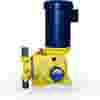Packed Plunger
The packed plunger style liquid end is the only liquid end in which the piston is in direct contact with the process fluid. This direct contact offers a number of advantages, including: high suction and discharge pressure capabilities; high temperature resistance, and lowest NPSH requirements. The reciprocating piston requires packing to seal the wetted parts from the atmosphere. This simple design is effective, but places limitations on the use of packed plunger pumps in certain applications. Because a small amount of controlled leakage past the packing must be expected, this style liquid end should not be used with hazardous or toxic chemicals. Additionally, the friction between the piston and the packing results in wear that increases leakage. Periodic packing adjustment is necessary to maintain volumetric efficiency. To avoid problems associated with leakage, consider a diaphragm style liquid end. The packed plunger can handle pressures up to 15,000 psi, and temperatures to 600℉ (with special modifications).






